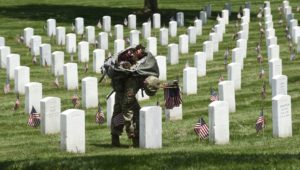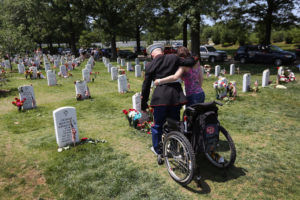May
24
Sacred Duty

Many people have heard of U.S. Senator Tom Cotton (R-AR), but they may not know of his military background. After graduating Harvard Law, Cotton joined the Army and rose to the rank of 1st Lieutenant, serving in Iraq with the 101st Airborne and in Afghanistan with a Provincial Reconstruction Team. He was also awarded various military decorations (e.g., Bronze Star, Combat Infantry Badge, Ranger Tab).
Between those two tours, Cotton was a platoon leader with the 3rd U.S. Infantry Regiment (aka “The Old Guard”), whose mission is to honor our country’s fallen heroes laid to rest at Arlington National Cemetery.
“The Old Guard has embodied the ideals of honor and sacrifice across our nation’s history. America’s oldest active-duty regiment, dating back to 1784, The Old Guard conducts daily military-honor funerals on the 624 rolling acres of Arlington, where generations of American heroes rest. Its soldiers hold themselves to the standard of perfection in sweltering heat, frigid cold, and driving rain. Every funeral is a no-fail, zero-defect mission, whether honoring a legendary general or a humble private.”
Cotton wrote a book about The Old Guard and about his time serving at Arlington, which he also spoke about in an April 2019 speech at Hillsdale College. The following is the beginning of an article adapted from that speech.
“Every headstone at Arlington tells a story. These are tales of heroes, I thought, as I placed the toe of my combat boot against the white marble. I pulled a miniature American flag out of my assault pack and pushed it three inches into the ground at my heel. I stepped aside to inspect it, making sure it met the standard that we had briefed to our troops: ‘vertical and perpendicular to the headstone.’ Satisfied, I moved to the next headstone to keep up with my soldiers. Having started this row, I had to complete it. One soldier per row was the rule; otherwise, different boot sizes might disrupt the perfect symmetry of the headstones and flags. I planted flag after flag, as did the soldiers on the rows around me.

Bending over to plant the flags brought me eye-level with the lettering on those marble stones. The stories continued with each one. Distinguished Service Cross. Silver Star. Bronze Star. Purple Heart. America’s wars marched by. Iraq. Afghanistan. Vietnam. Korea. World War II. World War I. Some soldiers died in very old age; others were teenagers. Crosses, Stars of David, Crescents and Stars. Every religion, every race, every age, every region of America is represented in these fields of stone.
I came upon the gravesite of a Medal of Honor recipient. I paused, came to attention, and saluted. The Medal of Honor is the nation’s highest decoration for battlefield valor. By military custom, all soldiers salute Medal of Honor recipients irrespective of their rank, in life and in death. We had reminded our soldiers of this courtesy; hundreds of grave sites would receive salutes that afternoon. I planted this hero’s flag and kept moving.
On some headstones sat a small memento: a rank or unit patch, a military coin, a seashell, sometimes just a penny or a rock. Each was a sign that someone — maybe family or friends, or perhaps a battle buddy who lived because of his friend’s ultimate sacrifice — had visited, honored, and mourned. For those of us who had been downrange, the sight was equally comforting and jarring — a sign that we would be remembered in death, but also a reminder of just how close some of us had come to resting here ourselves. We left those mementos undisturbed.
After a while, my hand began to hurt from pushing on the pointed, gold tips of the flags. There had been no rain that week, so the ground was hard. I asked my soldiers how they were moving so fast and seemingly pain-free. They asked if I was using a bottle cap, and I said no. Several shook their heads in disbelief; forgetting a bottle cap was apparently a mistake on par with forgetting one’s rifle or night-vision goggles on patrol in Iraq. Those kinds of little tricks and techniques were not briefed in the day’s written orders, but rather got passed down from seasoned soldiers. These details often make the difference between mission success or failure in the Army, whether in combat or stateside. After some good-natured ribbing at my expense, a young private squared me away with a spare cap.

We finished up our last section and got word over the radio to go place flags in the Columbarium, where open-air buildings contain thousands of urns. Walking down Arlington’s leafy avenues, we passed Section 60, where soldiers killed in Iraq and Afghanistan were laid to rest if their families chose Arlington as their eternal home. Unlike the sections we had just completed, several visitors and mourners were present. Some had settled in for a while on blankets or lawn chairs. Others walked among the headstones. Even from a respectful distance, we could see the sense of loss and grief on their faces.
Once we finished in the Columbarium, ‘mission complete’ came over the radio and we began the long walk up Arlington’s hills and back to Fort Myer. In just a few hours, we had placed a flag at every grave site in this sacred ground, more than two hundred thousand of them. From President John F. Kennedy to the Unknown Soldiers to the youngest privates from our oldest wars, every hero of Arlington had a few moments that day with a soldier who, in this simple act of remembrance, delivered a powerful message to the dead and the living alike: you are not forgotten.”
* Reprinted by permission from Imprimis, a publication of Hillsdale College.















